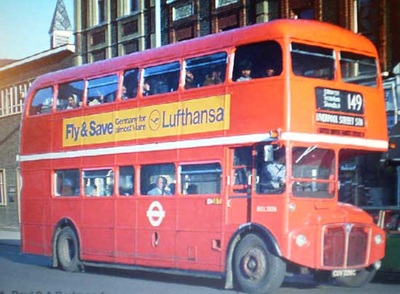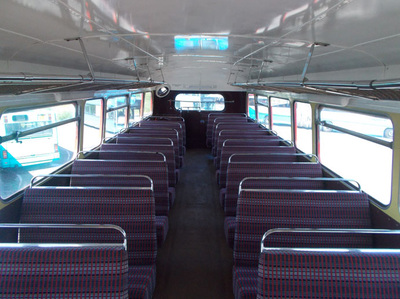Recent Photos
Older Photos
|
RCL2226
Seating Capacity:
69 (40 upstairs and 29 downstairs) Special features: PA system which makes this bus ideal for tours of London. Description:
The Routemaster truly is a London icon. Most of them served the capital for more than 50 years and are still as popular as ever. This bus is one of the special longer coach versions dating from 1965 and often referred to as the ‘Ultimate Routemaster’ they were built to be used on the express commuter Green Line services to & from London. To meet this requirement they had more comfortable seats, better lighting and greater speed. They were also fitted with platform doors making this vehicle ideal if your event is outside of the warmth of summer or involves long stretches on faster roads. It also means that a conductor is optional, as the driver can control the doors, thus allowing it to be one man operated and therefore offer very competitive rates and thus it’s one of our most popular buses. Vehicle History
Routemaster Class History:
The Routemaster or RM is without doubt one of the most famous types of bus ever to run in the capital. The original necessity was for vehicles to replace the Trolleybus which was due for replacement in 1959. Following a lot of research it had been decided to increase the capacity of London’s buses from 56, such as the RT, to 64. Following numerous changes and nearly five years of development the RM finally entered service. By 1962 the entire Trolleybus fleet had been replaced almost exclusively by Routemasters. In this period RM8-879 were all built and had entered service. Increasing the length and capacity of the RM was another contentious point, with both the Unions and Met Police being against the idea. However in 1961 a batch of 24, 30’ long 72 seat versions, known as the RML or Routemaster Lengthened, were built to trial. These took the numbers of RML880-904. Following this batch, whilst the trial continued with the longer versions, production continued on the standard length RM producing numbers RM905-1452. The next version was the batch between RMC1453-1520, which were built as Routemaster Coaches (RMC). These had such delights as deeper more comfortable seats, Green Line livery, powered rear doors, twin headlamps and interior luggage racks and were far quicker. Following this batch production again returned to the standard RM which ran through from the number RM1521-2217 which became the very last standard length RM built. Following the success of the RMC’s the next batch to be built, which were by many, seen as the zenith of RM design being the RCL’s. These took the numbers from RCL2218-2260 and were built to replace the Green Line RT’s on the busy (but declining) routes from Essex into Aldgate. Similar in comfort levels to the RMC they were a longer and more powerful version Permission had now been granted to run the longer RML’s in Central London and the final production batch ran from RML2261-2760 were all built to this specification. Two batches of 50 of these RML’s were built for the Country Area and were delivered in Green being RML2306-2355 and RML2411-2460. The final type of RM to enter service with London Transport was the RMA, or Routemaster Airport, version which originally ran for British European Airways bringing passengers to and fro between Central London and Heathrow before the Underground was extended there. The Routemaster was gradually withdrawn from London in the 1980’s before a change of plan saw many of the longer versions (and some standard length ones) be refurbished in 1990-92 when they received new engines, lighting and seating. In 2000-01 some had another refurbishment where they were fitted with more environmentally friendly engines and new gear boxes. However, the policy changed in 2003 and the final 20 routes were given warning that at next change of contract the vehicles required would not be RM’s. One by one these routes were withdrawn with the very last, the 159’s, finishing on December 9, 2005. However, such is the popularity of this type of vehicle that around 16 were retained for use on two heritage routes in Central London. For more on this class why not visit Ian's Bus Stop RCL2226 History RCL2226 was delivered in May 1965 initially to Grays where it was stored awaiting entry into service. The following month she moved to nearby Romford where she took up duties on the busy commuter routes 721/722/726 running from Essex into Aldgate bus station. In November she briefly moved to Hertford before again settling down to commuter duties in Romford until March 1968 when she moved again this time to Godstone. With the formation of London Country Bus Services, formally the green Country Area of London Transport RCL2226 found herself transferred to the new company but still plying her trade at Godstone. In January 1972 she went through her first major overhaul, returning to Godstone still in Green Line livery. In March 1976 she again changed garages heading south of the river to Northfleet, the stay here was pretty brief as in May she moved through the Dartford tunnel back to Grays garage where she was demoted to bus duties. As a bus she then moved to Crawley in June of 1977 before returning to Godstone in November, where the following September she was declared surplus to requirements and delicensed. The end appeared nigh when she was sold to Wombwell Diesels for scrap along with many other of her class. However London Transports shortage of buses was acute and it purchased many of London Country’s cast offs from the scrap yard and so it was 2226 returned to the capital, had doors removed, was reseated and converted to Central area specification and was duly painted red in September 1980 before taking up duties at Edmonton on the 149s. The shortage of buses gradually eased as the RCL buy backs found themselves once again facing an uncertain future when withdrawn in the summer of 1984. A buyer was found over a year later as she passed to Willy's Wheels who converted the vehicle to an industry on location catering vehicle. She remained in this role for nigh on the next twenty years in various guises and liveries until once again being found in a scrap yard and recovered by Ensignbus in 2006. Having to wait her turn for restoration work commenced after a hunt for the missing parts had eventually found everything that was required and whilst red on the outside the interior has been returned to as it would have been when new as a Green Line coach some 50 years ago. |



































